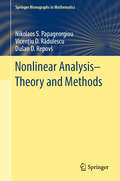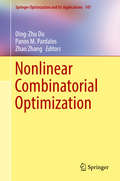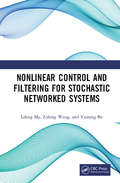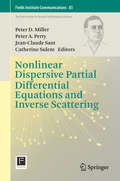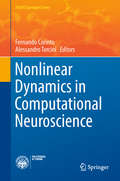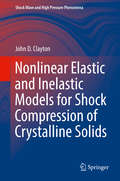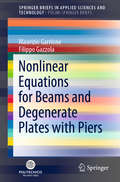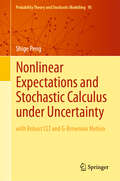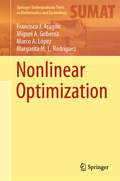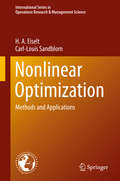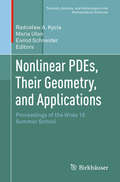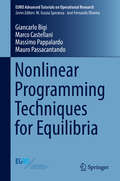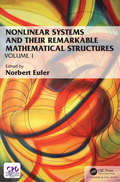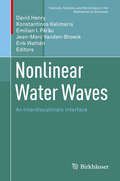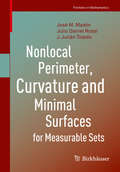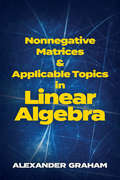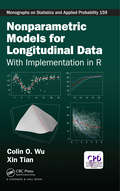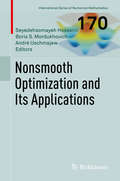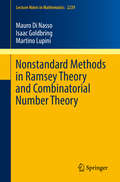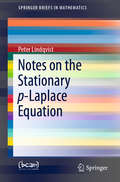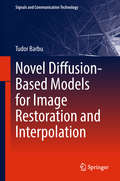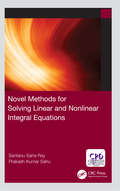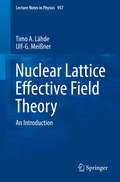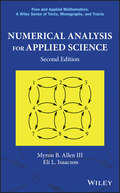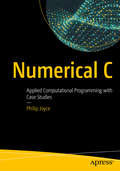- Table View
- List View
Nonlinear Analysis - Theory and Methods (Springer Monographs in Mathematics)
by Nikolaos S. Papageorgiou Vicenţiu D. Rădulescu Dušan D. RepovšThis book emphasizes those basic abstract methods and theories that are useful in the study of nonlinear boundary value problems. The content is developed over six chapters, providing a thorough introduction to the techniques used in the variational and topological analysis of nonlinear boundary value problems described by stationary differential operators. The authors give a systematic treatment of the basic mathematical theory and constructive methods for these classes of nonlinear equations as well as their applications to various processes arising in the applied sciences. They show how these diverse topics are connected to other important parts of mathematics, including topology, functional analysis, mathematical physics, and potential theory. Throughout the book a nice balance is maintained between rigorous mathematics and physical applications. The primary readership includes graduate students and researchers in pure and applied nonlinear analysis.
Nonlinear Combinatorial Optimization: Algorithms And Applications (Springer Optimization and Its Applications #147)
by Ding-Zhu Du Panos M. Pardalos Zhao ZhangGraduate students and researchers in applied mathematics, optimization, engineering, computer science, and management science will find this book a useful reference which provides an introduction to applications and fundamental theories in nonlinear combinatorial optimization. Nonlinear combinatorial optimization is a new research area within combinatorial optimization and includes numerous applications to technological developments, such as wireless communication, cloud computing, data science, and social networks. Theoretical developments including discrete Newton methods, primal-dual methods with convex relaxation, submodular optimization, discrete DC program, along with several applications are discussed and explored in this book through articles by leading experts.
Nonlinear Control and Filtering for Stochastic Networked Systems
by Lifeng Ma Zidong Wang Yuming BoIn this book, control and filtering problems for several classes of stochastic networked systems are discussed. In each chapter, the stability, robustness, reliability, consensus performance, and/or disturbance attenuation levels are investigated within a unified theoretical framework. The aim is to derive the sufficient conditions such that the resulting systems achieve the prescribed design requirements despite all the network-induced phenomena. Further, novel notions such as randomly occurring sensor failures and consensus in probability are discussed. Finally, the theories/techniques developed are applied to emerging research areas. Key Features Unifies existing and emerging concepts concerning stochastic control/filtering and distributed control/filtering with an emphasis on a variety of network-induced complexities Includes concepts like randomly occurring sensor failures and consensus in probability (with respect to time-varying stochastic multi-agent systems) Exploits the recursive linear matrix inequality approach, completing the square method, Hamilton-Jacobi inequality approach, and parameter-dependent matrix inequality approach to handle the emerging mathematical/computational challenges Captures recent advances of theories, techniques, and applications of stochastic control as well as filtering from an engineering-oriented perspective Gives simulation examples in each chapter to reflect the engineering practice
Nonlinear Dispersive Partial Differential Equations and Inverse Scattering (Fields Institute Communications #83)
by Peter D. Miller Peter A. Perry Jean-Claude Saut Catherine SulemThis volume contains lectures and invited papers from the Focus Program on "Nonlinear Dispersive Partial Differential Equations and Inverse Scattering" held at the Fields Institute from July 31-August 18, 2017. The conference brought together researchers in completely integrable systems and PDE with the goal of advancing the understanding of qualitative and long-time behavior in dispersive nonlinear equations. The program included Percy Deift’s Coxeter lectures, which appear in this volume together with tutorial lectures given during the first week of the focus program. The research papers collected here include new results on the focusing nonlinear Schrödinger (NLS) equation, the massive Thirring model, and the Benjamin-Bona-Mahoney equation as dispersive PDE in one space dimension, as well as the Kadomtsev-Petviashvili II equation, the Zakharov-Kuznetsov equation, and the Gross-Pitaevskii equation as dispersive PDE in two space dimensions. The Focus Program coincided with the fiftieth anniversary of the discovery by Gardner, Greene, Kruskal and Miura that the Korteweg-de Vries (KdV) equation could be integrated by exploiting a remarkable connection between KdV and the spectral theory of Schrodinger's equation in one space dimension. This led to the discovery of a number of completely integrable models of dispersive wave propagation, including the cubic NLS equation, and the derivative NLS equation in one space dimension and the Davey-Stewartson, Kadomtsev-Petviashvili and Novikov-Veselov equations in two space dimensions. These models have been extensively studied and, in some cases, the inverse scattering theory has been put on rigorous footing. It has been used as a powerful analytical tool to study global well-posedness and elucidate asymptotic behavior of the solutions, including dispersion, soliton resolution, and semiclassical limits.
Nonlinear Dynamics in Computational Neuroscience (PoliTO Springer Series)
by Fernando Corinto Alessandro TorciniThis book provides an essential overview of computational neuroscience. It addresses a broad range of aspects, from physiology to nonlinear dynamical approaches to understanding neural computation, and from the simulation of brain circuits to the development of engineering devices and platforms for neuromorphic computation. Written by leading experts in such diverse fields as neuroscience, physics, psychology, neural engineering, cognitive science and applied mathematics, the book reflects the remarkable advances that have been made in the field of computational neuroscience, an emerging discipline devoted to the study of brain functions in terms of the information-processing properties of the structures forming the nervous system. The contents build on the workshop “Nonlinear Dynamics in Computational Neuroscience: from Physics and Biology to ICT,” which was held in Torino, Italy in September 2015.
Nonlinear Elastic and Inelastic Models for Shock Compression of Crystalline Solids (Shock Wave and High Pressure Phenomena)
by John D. ClaytonThis book describes thermoelastic and inelastic deformation processes in crystalline solids undergoing loading by shock compression. Constitutive models with a basis in geometrically nonlinear continuum mechanics supply these descriptions. Large deformations such as finite strains and rotations, are addressed. The book covers dominant mechanisms of nonlinear thermoelasticity, dislocation plasticity, deformation twinning, fracture, flow, and other structure changes. Rigorous derivations of theoretical results are provided, with approximately 1300 numbered equations and an extensive bibliography of over 500 historical and modern references spanning from the 1920s to the present day. Case studies contain property data, as well as analytical, and numerical solutions to shock compression problems for different materials. Such materials are metals, ceramics, and minerals, single crystalline and polycrystalline.The intended audience of this book is practicing scientists (physicists, engineers, materials scientists, and applied mathematicians) involved in advanced research on shock compression of solid materials.
Nonlinear Equations for Beams and Degenerate Plates with Piers (SpringerBriefs in Applied Sciences and Technology)
by Maurizio Garrione Filippo GazzolaThis book develops a full theory for hinged beams and degenerate plates with multiple intermediate piers with the final purpose of understanding the stability of suspension bridges. New models are proposed and new tools are provided for the stability analysis. The book opens by deriving the PDE’s based on the physical models and by introducing the basic framework for the linear stationary problem. The linear analysis, in particular the behavior of the eigenvalues as the position of the piers varies, enables the authors to tackle the stability issue for some nonlinear evolution beam equations, with the aim of determining the “best position” of the piers within the beam in order to maximize its stability. The study continues with the analysis of a class of degenerate plate models. The torsional instability of the structure is investigated, and again, the optimal position of the piers in terms of stability is discussed. The stability analysis is carried out by means of both analytical tools and numerical experiments. Several open problems and possible future developments are presented. The qualitative analysis provided in the book should be seen as the starting point for a precise quantitative study of more complete models, taking into account the action of aerodynamic forces. This book is intended for a two-fold audience. It is addressed both to mathematicians working in the field of Differential Equations, Nonlinear Analysis and Mathematical Physics, due to the rich number of challenging mathematical questions which are discussed and left as open problems, and to Engineers interested in mechanical structures, since it provides the theoretical basis to deal with models for the dynamics of suspension bridges with intermediate piers. More generally, it may be enjoyable for readers who are interested in the application of Mathematics to real life problems.
Nonlinear Expectations and Stochastic Calculus under Uncertainty: with Robust CLT and G-Brownian Motion (Probability Theory and Stochastic Modelling #95)
by Shige PengThis book is focused on the recent developments on problems of probability model uncertainty by using the notion of nonlinear expectations and, in particular, sublinear expectations. It provides a gentle coverage of the theory of nonlinear expectations and related stochastic analysis. Many notions and results, for example, G-normal distribution, G-Brownian motion, G-Martingale representation theorem, and related stochastic calculus are first introduced or obtained by the author.This book is based on Shige Peng’s lecture notes for a series of lectures given at summer schools and universities worldwide. It starts with basic definitions of nonlinear expectations and their relation to coherent measures of risk, law of large numbers and central limit theorems under nonlinear expectations, and develops into stochastic integral and stochastic calculus under G-expectations. It ends with recent research topic on G-Martingale representation theorem and G-stochastic integral for locally integrable processes.With exercises to practice at the end of each chapter, this book can be used as a graduate textbook for students in probability theory and mathematical finance. Each chapter also concludes with a section Notes and Comments, which gives history and further references on the material covered in that chapter.Researchers and graduate students interested in probability theory and mathematical finance will find this book very useful.
Nonlinear Optimization (Springer Undergraduate Texts in Mathematics and Technology)
by Miguel A. Goberna Marco A. López Francisco J. Aragón Margarita M.L. RodríguezThis textbook on nonlinear optimization focuses on model building, real world problems, and applications of optimization models to natural and social sciences. Organized into two parts, this book may be used as a primary text for courses on convex optimization and non-convex optimization. Definitions, proofs, and numerical methods are well illustrated and all chapters contain compelling exercises. The exercises emphasize fundamental theoretical results on optimality and duality theorems, numerical methods with or without constraints, and derivative-free optimization. Selected solutions are given. Applications to theoretical results and numerical methods are highlighted to help students comprehend methods and techniques.
Nonlinear Optimization: Methods and Applications (International Series in Operations Research & Management Science #282)
by H. A. Eiselt Carl-Louis SandblomThis book provides a comprehensive introduction to nonlinear programming, featuring a broad range of applications and solution methods in the field of continuous optimization. It begins with a summary of classical results on unconstrained optimization, followed by a wealth of applications from a diverse mix of fields, e.g. location analysis, traffic planning, and water quality management, to name but a few. In turn, the book presents a formal description of optimality conditions, followed by an in-depth discussion of the main solution techniques. Each method is formally described, and then fully solved using a numerical example.
Nonlinear PDEs, Their Geometry, and Applications: Proceedings of the Wisła 18 Summer School (Tutorials, Schools, and Workshops in the Mathematical Sciences)
by Radosław A. Kycia Maria Ułan Eivind SchneiderThis volume presents lectures given at the Summer School Wisła 18: Nonlinear PDEs, Their Geometry, and Applications, which took place from August 20 - 30th, 2018 in Wisła, Poland, and was organized by the Baltic Institute of Mathematics. The lectures in the first part of this volume were delivered by experts in nonlinear differential equations and their applications to physics. Original research articles from members of the school comprise the second part of this volume. Much of the latter half of the volume complements the methods expounded in the first half by illustrating additional applications of geometric theory of differential equations. Various subjects are covered, providing readers a glimpse of current research. Other topics covered include thermodynamics, meteorology, and the Monge–Ampère equations.Researchers interested in the applications of nonlinear differential equations to physics will find this volume particularly useful. A knowledge of differential geometry is recommended for the first portion of the book, as well as a familiarity with basic concepts in physics.
Nonlinear Programming Techniques for Equilibria (EURO Advanced Tutorials on Operational Research)
by Giancarlo Bigi Marco Castellani Massimo Pappalardo Mauro PassacantandoThis book considers a range of problems in operations research, which are formulated through various mathematical models such as complementarity, variational inequalities, multiobjective optimization, fixed point problems, noncooperative games and inverse optimization. Moreover, the book subsumes all these models under a common structure that allows them to be formulated in a unique format: the Ky Fan inequality. It subsequently focuses on this unifying equilibrium format, providing a comprehensive overview of the main theoretical results and solution algorithms, together with a wealth of applications and numerical examples. Particular emphasis is placed on the role of nonlinear optimization techniques – e.g. convex optimization, nonsmooth calculus, proximal point and descent algorithms – as valuable tools for analyzing and solving Ky Fan inequalities.
Nonlinear Systems and Their Remarkable Mathematical Structures: Volume 1
by Norbert EulerNonlinear Systems and Their Remarkable Mathematical Structures, Volume 1 aims to describe the recent progress in nonlinear differential equations and nonlinear dynamical systems (both continuous and discrete). Written by experts, each chapter is self-contained and aims to clearly illustrate some of the mathematical theories of nonlinear systems. The book should be suitable for some graduate and postgraduate students in mathematics, the natural sciences, and engineering sciences, as well as for researchers (both pure and applied) interested in nonlinear systems. The common theme throughout the book is on solvable and integrable nonlinear systems of equations and methods/theories that can be applied to analyze those systems. Some applications are also discussed.Features: Collects contributions on recent advances in the subject of nonlinear systems Aims to make the advanced mathematical methods accessible to the non-expert in this field Written to be accessible to some graduate and postgraduate students in mathematics and applied mathematics Serves as a literature source in nonlinear systems
Nonlinear Water Waves: An Interdisciplinary Interface (Tutorials, Schools, and Workshops in the Mathematical Sciences)
by David Henry Konstantinos Kalimeris Emilian I. Părău Jean-Marc Vanden-Broeck Erik WahlénThe motion of water is governed by a set of mathematical equations which are extremely complicated and intractable. This is not surprising when one considers the highly diverse and intricate physical phenomena which may be exhibited by a given body of water. Recent mathematical advances have enabled researchers to make major progress in this field, reflected in the topics featured in this volume. Cutting-edge techniques and tools from mathematical analysis have generated strong rigorous results concerning the qualitative and quantitative physical properties of solutions of the governing equations. Furthermore, accurate numerical computations of fully-nonlinear steady and unsteady water waves in two and three dimensions have contributed to the discovery of new types of waves. Model equations have been derived in the long-wave and modulational regime using Hamiltonian formulations and solved numerically. This book brings together interdisciplinary researchers working in the field of nonlinear water waves, whose contributions range from survey articles to new research results which address a variety of aspects in nonlinear water waves. It is motivated by a workshop which was organised at the Erwin Schrödinger International Institute for Mathematics and Physics in Vienna, November 27-December 7, 2017. The key aim of the workshop was to describe, and foster, new approaches to research in this field. This is reflected in the contents of this book, which is aimed to stimulate both experienced researchers and students alike.
Nonlocal Perimeter, Curvature and Minimal Surfaces for Measurable Sets (Frontiers in Mathematics)
by José M. Mazón Julio Daniel Rossi J. Julián ToledoThis book highlights the latest developments in the geometry of measurable sets, presenting them in simple, straightforward terms. It addresses nonlocal notions of perimeter and curvature and studies in detail the minimal surfaces associated with them. These notions of nonlocal perimeter and curvature are defined on the basis of a non-singular kernel. Further, when the kernel is appropriately rescaled, they converge toward the classical perimeter and curvature as the rescaling parameter tends to zero. In this way, the usual notions can be recovered by using the nonlocal ones. In addition, nonlocal heat content is studied and an asymptotic expansion is obtained. Given its scope, the book is intended for undergraduate and graduate students, as well as senior researchers interested in analysis and/or geometry.
Nonnegative Matrices and Applicable Topics in Linear Algebra (Dover Books on Mathematics)
by Alexander GrahamNonnegative matrices is an increasingly important subject in economics, control theory, numerical analysis, Markov chains, and other areas. This concise treatment is directed toward undergraduates who lack specialized knowledge at the postgraduate level of mathematics and related fields, such as mathematical economics and operations research.An Introductory Survey encompasses some aspects of matrix theory and its applications and other relevant topics in linear algebra, including certain facets of graph theory. Subsequent chapters cover various points of the theory of normal matrices, comprising unitary and Hermitian matrices, and the properties of positive definite matrices. An exploration of the main topic, nonnegative matrices, is followed by a discussion of M-matrices. The final chapter examines stochastic, genetic, and economic models. The important concepts are illustrated by simple worked examples. Problems appear at the conclusion of most chapters, with solutions at the end of the book.
Nonparametric Models for Longitudinal Data: With Implementation in R (Chapman & Hall/CRC Monographs on Statistics and Applied Probability)
by Colin O. Wu Xin TianNonparametric Models for Longitudinal Data with Implementations in R presents a comprehensive summary of major advances in nonparametric models and smoothing methods with longitudinal data. It covers methods, theories, and applications that are particularly useful for biomedical studies in the era of big data and precision medicine. It also provides flexible tools to describe the temporal trends, covariate effects and correlation structures of repeated measurements in longitudinal data. This book is intended for graduate students in statistics, data scientists and statisticians in biomedical sciences and public health. As experts in this area, the authors present extensive materials that are balanced between theoretical and practical topics. The statistical applications in real-life examples lead into meaningful interpretations and inferences. Features: Provides an overview of parametric and semiparametric methods Shows smoothing methods for unstructured nonparametric models Covers structured nonparametric models with time-varying coefficients Discusses nonparametric shared-parameter and mixed-effects models Presents nonparametric models for conditional distributions and functionals Illustrates implementations using R software packages Includes datasets and code in the authors’ website Contains asymptotic results and theoretical derivations Both authors are mathematical statisticians at the National Institutes of Health (NIH) and have published extensively in statistical and biomedical journals. Colin O. Wu earned his Ph.D. in statistics from the University of California, Berkeley (1990), and is also Adjunct Professor at the Georgetown University School of Medicine. He served as Associate Editor for Biometrics and Statistics in Medicine, and reviewer for National Science Foundation, NIH, and the U.S. Department of Veterans Affairs. Xin Tian earned her Ph.D. in statistics from Rutgers, the State University of New Jersey (2003). She has served on various NIH committees and collaborated extensively with clinical researchers.
Nonsmooth Optimization and Its Applications (International Series of Numerical Mathematics #170)
by Seyedehsomayeh Hosseini Boris S. Mordukhovich André UschmajewSince nonsmooth optimization problems arise in a diverse range of real-world applications, the potential impact of efficient methods for solving such problems is undeniable. Even solving difficult smooth problems sometimes requires the use of nonsmooth optimization methods, in order to either reduce the problem’s scale or simplify its structure. Accordingly, the field of nonsmooth optimization is an important area of mathematical programming that is based on by now classical concepts of variational analysis and generalized derivatives, and has developed a rich and sophisticated set of mathematical tools at the intersection of theory and practice.This volume of ISNM is an outcome of the workshop "Nonsmooth Optimization and its Applications," which was held from May 15 to 19, 2017 at the Hausdorff Center for Mathematics, University of Bonn. The six research articles gathered here focus on recent results that highlight different aspects of nonsmooth and variational analysis, optimization methods, their convergence theory and applications.
Nonstandard Methods in Ramsey Theory and Combinatorial Number Theory (Lecture Notes in Mathematics #2239)
by Mauro Di Nasso Isaac Goldbring Martino LupiniThe goal of this monograph is to give an accessible introduction to nonstandard methods and their applications, with an emphasis on combinatorics and Ramsey theory. It includes both new nonstandard proofs of classical results and recent developments initially obtained in the nonstandard setting. This makes it the first combinatorics-focused account of nonstandard methods to be aimed at a general (graduate-level) mathematical audience. This book will provide a natural starting point for researchers interested in approaching the rapidly growing literature on combinatorial results obtained via nonstandard methods. The primary audience consists of graduate students and specialists in logic and combinatorics who wish to pursue research at the interface between these areas.
Notes on the Stationary p-Laplace Equation (SpringerBriefs in Mathematics)
by Peter LindqvistThis book in the BCAM SpringerBriefs series is a treatise on the p-Laplace equation. It is based on lectures by the author that were originally delivered at the Summer School in Jyväskylä, Finland, in August 2005 and have since been updated and extended to cover various new topics, including viscosity solutions and asymptotic mean values. The p-Laplace equation is a far-reaching generalization of the ordinary Laplace equation, but it is non-linear and degenerate (p>2) or singular (p
Novel Diffusion-Based Models for Image Restoration and Interpolation (Signals and Communication Technology)
by Tudor BarbuThis book covers two essential PDE-based image processing fields: image denoising and image inpainting. It describes the state-of-the-art PDE-based image restoration and interpolation (inpainting) techniques, focusing on the latest advances in PDE-based image processing and analysis, and explores novel techniques involving diffusion-based models and variational schemes. The PDE and variational schemes clearly outperform the conventional approaches in these areas, and can successfully remove image noise and reconstruct missing or highly degraded regions, while preserving the essential features and avoiding unintended effects. The book addresses researchers and graduate students, but is also well suited for professionals in both the mathematics and electrical engineering domains, as it provides rigorous mathematical investigations of the image processing models described, as well as mathematical treatments for the numerical approximation schemes of these differential models.
Novel Methods for Solving Linear and Nonlinear Integral Equations
by Santanu Saha Ray Prakash Kumar SahuThis book deals with the numerical solution of integral equations based on approximation of functions and the authors apply wavelet approximation to the unknown function of integral equations. The book's goal is to categorize the selected methods and assess their accuracy and efficiency.
Nuclear Lattice Effective Field Theory: An Introduction (Lecture Notes in Physics #957)
by Timo A. Lähde Ulf-G. MeißnerThis primer begins with a brief introduction to the main ideas underlying Effective Field Theory (EFT) and describes how nuclear forces are obtained from first principles by introducing a Euclidean space-time lattice for chiral EFT. It subsequently develops the related technical aspects by addressing the two-nucleon problem on the lattice and clarifying how it fixes the numerical values of the low-energy constants of chiral EFT. In turn, the spherical wall method is introduced and used to show how improved lattice actions render higher-order corrections perturbative. The book also presents Monte Carlo algorithms used in actual calculations. In the last part of the book, the Euclidean time projection method is introduced and used to compute the ground-state properties of nuclei up to the mid-mass region. In this context, the construction of appropriate trial wave functions for the Euclidean time projection is discussed, as well as methods for determining the energies of the low-lying excitations and their spatial structure. In addition, the so-called adiabatic Hamiltonian, which allows nuclear reactions to be precisely calculated, is introduced using the example of alpha-alpha scattering. In closing, the book demonstrates how Nuclear Lattice EFT can be extended to studies of unphysical values of the fundamental parameters, using the triple-alpha process as a concrete example with implications for the anthropic view of the Universe. Nuclear Lattice Effective Field Theory offers a concise, self-contained, and introductory text suitable for self-study use by graduate students and newcomers to the field of modern computational techniques for atomic nuclei and nuclear reactions.
Numerical Analysis for Applied Science (Pure and Applied Mathematics: A Wiley Series of Texts, Monographs and Tracts #35)
by Myron B. Allen III Eli L. IsaacsonPragmatic and Adaptable Textbook Meets the Needs of Students and Instructors from Diverse Fields Numerical analysis is a core subject in data science and an essential tool for applied mathematicians, engineers, and physical and biological scientists. This updated and expanded edition of Numerical Analysis for Applied Science follows the tradition of its precursor by providing a modern, flexible approach to the theory and practical applications of the field. As before, the authors emphasize the motivation, construction, and practical considerations before presenting rigorous theoretical analysis. This approach allows instructors to adapt the textbook to a spectrum of uses, ranging from one-semester, methods-oriented courses to multi-semester theoretical courses. The book includes an expanded first chapter reviewing useful tools from analysis and linear algebra. Subsequent chapters include clearly structured expositions covering the motivation, practical considerations, and theory for each class of methods. The book includes over 250 problems exploring practical and theoretical questions and 32 pseudocodes to help students implement the methods. Other notable features include: A preface providing advice for instructors on using the text for a single semester course or multiple-semester sequence of courses Discussion of topics covered infrequently by other texts at this level, such as multidimensional interpolation, quasi-Newton methods in several variables, multigrid methods, preconditioned conjugate-gradient methods, finite-difference methods for partial differential equations, and an introduction to finite-element theory New topics and expanded treatment of existing topics to address developments in the field since publication of the first edition More than twice as many computational and theoretical exercises as the first edition. Numerical Analysis for Applied Science, Second Edition provides an excellent foundation for graduate and advanced undergraduate courses in numerical methods and numerical analysis. It is also an accessible introduction to the subject for students pursuing independent study in applied mathematics, engineering, and the physical and life sciences and a valuable reference for professionals in these areas.
Numerical C: Applied Computational Programming with Case Studies
by Philip JoyceLearn applied numerical computing using the C programming language, starting with a quick primer on the C programming language and its SDK. This book then dives into progressively more complex applied math formula for computational methods using C with examples throughout and a larger, more complete application towards the end. Numerical C starts with the quadratic formula for finding solutions to algebraic equations that model things such as price vs. demand or rise vs. run or slip and more. Later in the book, you'll work on the augmented matrix method for simultaneous equations. You’ll also cover Monte Carlo method model objects that could arise naturally as part of the modeling of a real-life system, such as a complex road network, the transport of neutrons, or the evolution of the stock market. Furthermore, the Monte Carlo method of integration examines the area under a curve including rendering or ray tracing and the shading in a region. Furthermore, you'll work with the product moment correlation coefficient: correlation is a technique for investigating the relationship between two quantitative, continuous variables, for example, age and blood pressure. By the end of the book, you'll have a feeling for what computer software could do to help you in your work and apply some of the methods learned directly to your work. What You Will LearnGain software and C programming basicsWrite software to solve applied, computational mathematics problems Create programs to solve equations and calculus problems Use the trapezium method, Monte Carlo method, line of best fit, product moment correlation coefficient, Simpson’s rule, and matrix solutions Write code to solve differential equations Apply one or more of the methods to an application case studyWho This Book Is ForThose with an existing knowledge of rudimentary mathematics (school level) and some basic programming experience. This is also important to people who may work in mathematics or other areas (for example, life sciences, engineering, or economics) and need to learn C programming.
